Individual Italian Easter Bread Rings…Easy Step by Step Directions
Individual Italian Easter Bread Rings are baked around an egg, and decorated with icing and sprinkles. Not only are they really easy to make, but make the perfect Italian Easter dessert. Make one large ring if you prefer, but this authentic, traditional Italian Easter bread will elate children and adults alike!
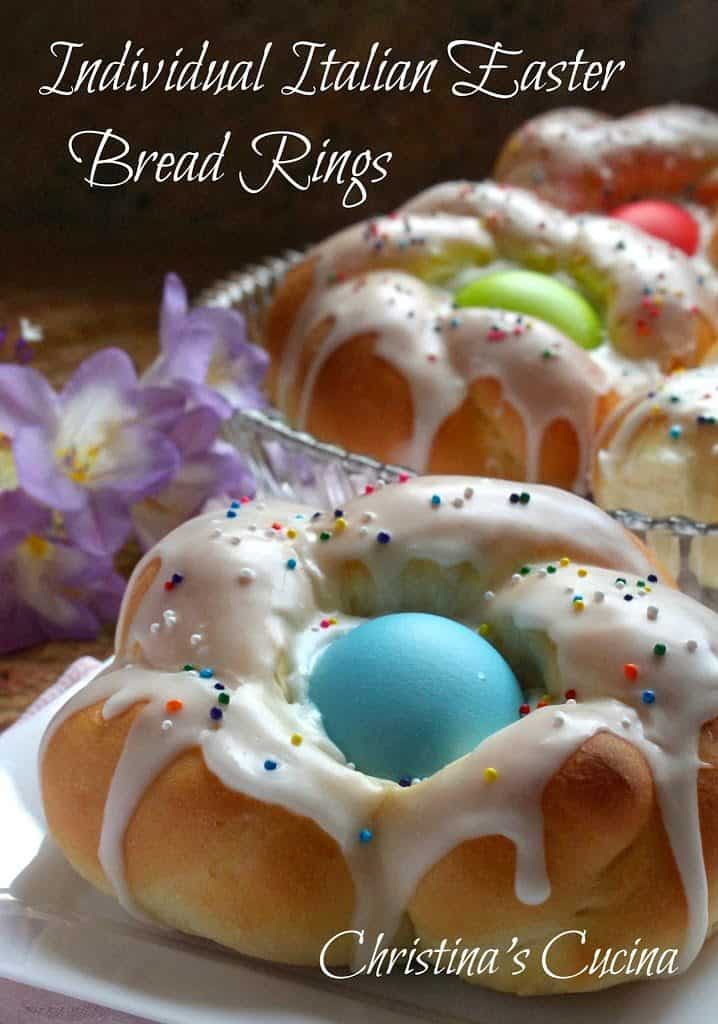
Originally published A .
Before you decide that there’s no way that you can make these lovely, individual Italian Easter bread rings, let me tell you that if you have a bread machine or stand mixer, they are very easy to make! If you don’t have either machine, the only thing is that making the dough will be a bit more time-consuming, but still easy.
As an Amazon Associate I earn from qualifying purchases.
The bread machine (the link takes you to the one I have, but there are many to choose from, starting at about $50) or a stand mixer will make the dough for you, which is the most time-consuming part. Once you have the dough, if you can roll and pinch it, you have all the necessary skills (little ones love to make these-my children helped to make them every Easter).
You may also enjoy Mrs. Rabbit’s Hot Cross Buns! Better than Mary Berry’s!
Not only are Italian Easter bread rings beautiful, but the light, airy texture of brioche-like dough perfectly partners with the sweetness of the icing. They can do double duty by providing a beautiful table decor for your Easter table, too!
Can I Make the Italian Easter Bread Dough the Night Before?
Yes, you can make it and let it rise in the fridge overnight. Here’s what to do once you’ve made the dough: don’t let it rise in the bread machine or bowl. Place it in a large container with a lid, or a sealed bowl, with sufficient space for it to rise and put it in the fridge. In the morning, proceed from the first rise (knead and shape). Try to make it as late in the day as you can as you not want the dough to overproof.
Here’s another Italian Easter bread you can try: pigna di Pasqua!
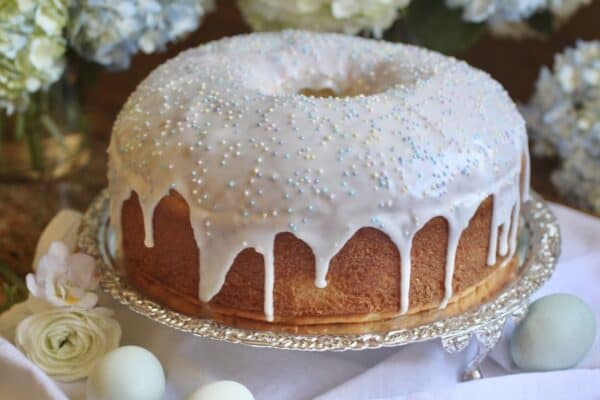
Take a look at the step by step photos and you’ll see, you can make these lovely Italian Easter bread Rings.
You may also like this recipe for a Colomba di Pasqua (Italian Easter dove bread)
IF YOU MAKE THIS RECIPE AND ENJOY THE BREAD, PLEASE LEAVE A 5 STAR RATING
IN THE RECIPE CARD BELOW ~ THANK YOU! 🙏🏻
Individual Italian Easter Bread Rings
Recipe by Christina Conte (adapted from my doughnut recipe) Makes 6 rings
Full printable recipe below
BREAD MACHINE (FOR STAND MIXER DIRECTIONS, SEE BELOW.)
Heat milk and butter gently, in a small saucepan, just until butter melts.
Remove from heat and place in bread machine pan.
Beat eggs, just to break yolks, then add to milk and butter in pan, then add the dry ingredients: flour, salt and sugar.
Make a well in the center of the dry ingredients and add the yeast.
Set machine for “dough” and press “start.”
This is what the dough should look like after it is finished kneading. It should be very soft and pliable, but not sticky. If it is very wet or very sticky, add a little flour and let it knead again.
Let rise until doubled.
IF USING A STAND MIXER: place lukewarm milk in a jug and sprinkle the yeast on top with a pinch of sugar, and allow to rest for about 5 minutes. Meanwhile, place the rest of the dry ingredients in the mixing bowl and make a well in the center. Melt the butter, (but make sure it’s not hot when you add it to the bowl or it can kill the yeast), and slightly beat the eggs in a separate bowl.
Pour the milk and yeast mixture, melted butter and beaten eggs into the well in the flour. Using the dough hook, start the machine slowly, until a dough begins to form, then increase the speed a little and allow to knead for about 10 minutes. Dough should be smooth, and a bit firm. Cover with plastic wrap and allow to rise until doubled. If it is cold in your kitchen you can place the bowl, uncovered, in your oven, along with a jug of boiling water alongside it (or just keep it covered with the plastic wrap).
If you do warm your oven at all, please just turn it on for 1 or 2 minutes, then turn it off, as the bread won’t turn out correctly if it rises under overheated conditions). These directions can also be followed if you want to make these by hand.
WHETHER USING THE BREAD MACHINE OR STAND MIXER, CONTINUE HERE…
Put the dough onto a lightly floured mat or counter and knead gently, then cut into 6 equal pieces.
Cut each of the 6 pieces in half and roll out to about 9 inches long. It doesn’t have to look pretty at this point.
Pinch one end together.
Now twist the two ropes together like this. Again, it won’t look very pretty, but it’s okay; pinch the other end together.
Next, join the ends to each other to form a ring, twisting as necessary to keep the ropes from undoing themselves. Place a colored egg into the center of the ring. If you’d like to make ONE large Italian Easter bread ring, do so by using all of the dough to make one large twisted ring. Afterwards, place the 5 eggs nestled evenly into the dough.
Place the ring on a silicone sheet or parchment lined baking tray and continue with the rest of the dough and eggs.
Once you have made all six, place them in a slightly warm oven to rise for about an hour.
After they have risen, remove the tray from the oven and turn it on to 350°F (175°C).
When the oven is at the correct temperature, bake the rings for 20 to 25 minutes or until golden brown, turning the tray midway through baking, if necessary, for even browning.
Remove from the oven and place the Italian Easter bread rings on a cooling rack.
When the bread rings are cool, mix together confectioner’s sugar, vanilla and milk to make a slightly runny glaze. Glaze rings, adjusting with more sugar or milk for correct consistency.
See the photo below: the drip in the forefront ran too quickly, so I made the icing thicker, and you can see it looks much better as it pours onto the ring.
The glaze should slowly drip down the side of the ring.
Immediately add colored sprinkles, if desired, and allow glaze to harden/dry before serving.
See? They’re not difficult to make at all!
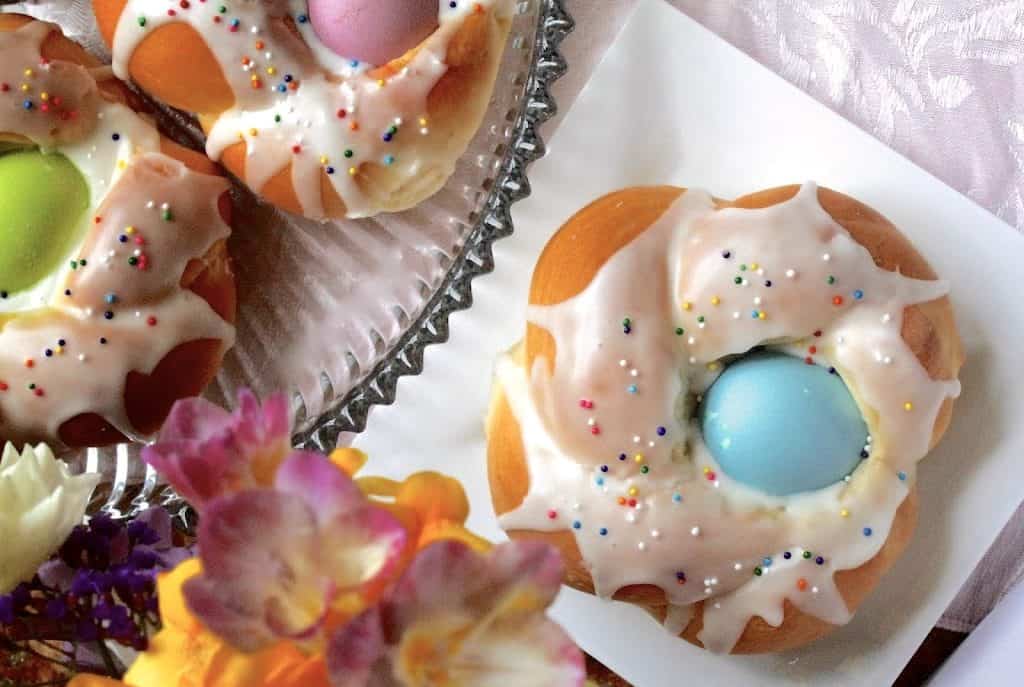
NOTE: due to the fact that these are made from brioche dough, iced and have an egg in the middle, I don’t advise making these too far in advance. In fact, I usually have the dough ready and shape and bake them on Easter morning because I love them fresh. If you do make them in advance, try to make them the night before, but if keeping them out for longer than a few hours, or if it’s really warm, they should be refrigerated because of the egg.
Happy Easter!!
Don’t miss another post! Sign up for my free subscription for recipes and travel.
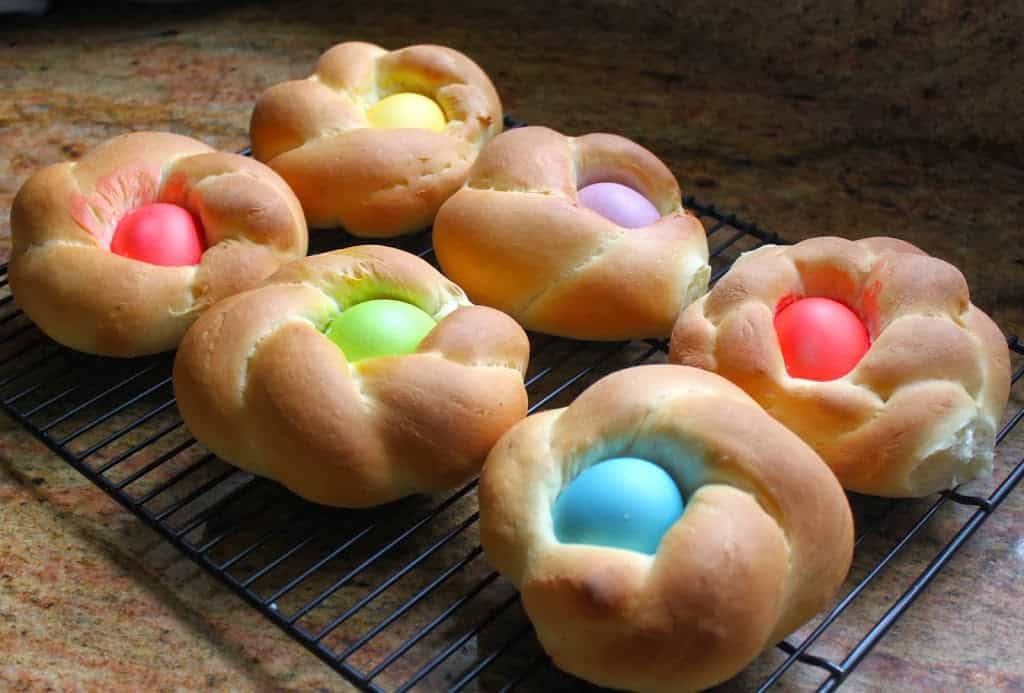
Individual Italian Easter Bread Rings...Easy Step by Step Directions
Ingredients
- 8 eggs 6 should be colored, but still raw; DO NOT USE HARDBOILED EGGS
- 2 Tbsp butter
- ⅔ cup milk
- 3 to 3 ½ cups all-purpose flour (good quality)
- ¼ cup sugar
- 1 tsp sea salt
- 1 ½ tsp dry yeast (for bread machine)
For glaze:
- ¾ cup confectioner’s sugar
- 2 Tbsp milk
- ½ tsp vanilla
Instructions
BREAD MACHINE DIRECTIONS (FOR STAND MIXER DIRECTIONS, SEE BELOW.)
- Heat milk and butter gently, in a small saucepan, just until butter melts.
- Remove from heat and place in bread machine pan.
- Beat 2 uncolored eggs, just to break up the yolks, then add to milk and butter in pan. Next, add the dry ingredients: flour, salt and sugar.
- Make a well in the center of the dry ingredients and add the yeast. Set machine for "dough" and press "start."
- The dough will be very soft and pliable, but not sticky. If it is very wet or very sticky, add a little flour and let it knead again. Let rise until doubled.
IF USING A STAND MIXER:
- Place lukewarm milk in a jug and sprinkle the yeast on top with a pinch of sugar, and allow to rest for about 5 minutes. Meanwhile, place the rest of the dry ingredients in the mixing bowl and make a well in the center. Melt the butter, (but make sure it's not hot when you add it to the bowl or it can kill the yeast), and slightly beat the eggs in a separate bowl.
- Pour the milk and yeast mixture, melted butter and beaten eggs into the well in the flour. Using the dough hook, start the machine slowly, until a dough begins to form, then increase the speed a little and allow to knead for about 10 minutes. Dough should be smooth, and a bit firm.
- Cover with plastic wrap and allow to rise until doubled. If it is cold in your kitchen you can place the bowl, uncovered, in your oven, along with a jug of boiling water alongside it (or just keep it covered with the plastic wrap). If you do warm your oven at all, please just turn it on for 1 or 2 minutes, then turn it off, as the bread won't turn out correctly if it rises under overheated conditions). These directions can also be followed if you want to make these by hand.
WHETHER USING THE BREAD MACHINE OR STAND MIXER, CONTINUE HERE...
- Put the dough onto a lightly floured mat or counter and knead gently, then cut into 6 equal pieces.
- Cut each of the 6 pieces in half and roll out to about 9 inches long. It doesn't have to look pretty at this point. Pinch one end together.
- Now twist the two ropes together like this. Again, it won't look very pretty, but it's okay; pinch the other end together.
- Next, join the ends to each other to form a ring, twisting as necessary to keep the ropes from undoing themselves. Place a colored egg into the center of the ring.
- (If you'd like to make ONE large Italian Easter bread ring, do so by using all of the dough to make one large twisted ring. Afterwards, place the 5 eggs nestled evenly into the dough.)
- Place the ring on a silicone sheet or a parchment lined baking sheet and continue with the rest of the dough and eggs.
- Once you have made all six, place them in a slightly warm oven to rise for about an hour.
- After they have risen, remove from the oven and turn the heat to 350°F (175°C).
- When oven is at the correct temperature, bake the rings for 20 to 25 minutes or until golden brown, turning the tray midway through baking if necessary for even browning.
- Remove from tray and place the Italian Easter bread rings on a cooling rack.
- When rings are cool, mix together confectioner's sugar, vanilla and milk to make a slightly runny glaze. Glaze rings, adjusting with more sugar or milk for correct consistency.
- See the photo below: the drip in the forefront ran too quickly, so I made the icing thicker, and you can see it looks much better as it pours onto the ring. The glaze should slowly drip down the side of the ring.
- Sprinkle with colored sprinkles if desired, and allow glaze to harden/dry before serving.
Notes
- You can use 5 eggs and make one large braid if you don't want individual Easter bread rings.
Nutrition
Sweet Crispy Easter Pasta Nests
Casatiello (Neapolitan Easter Bread)
Christina’s Cucina is a participant in the Amazon Services LLC Associates Program, an affiliate advertising program designed to provide a means for sites to earn advertising fees by advertising and linking to Amazon.com.



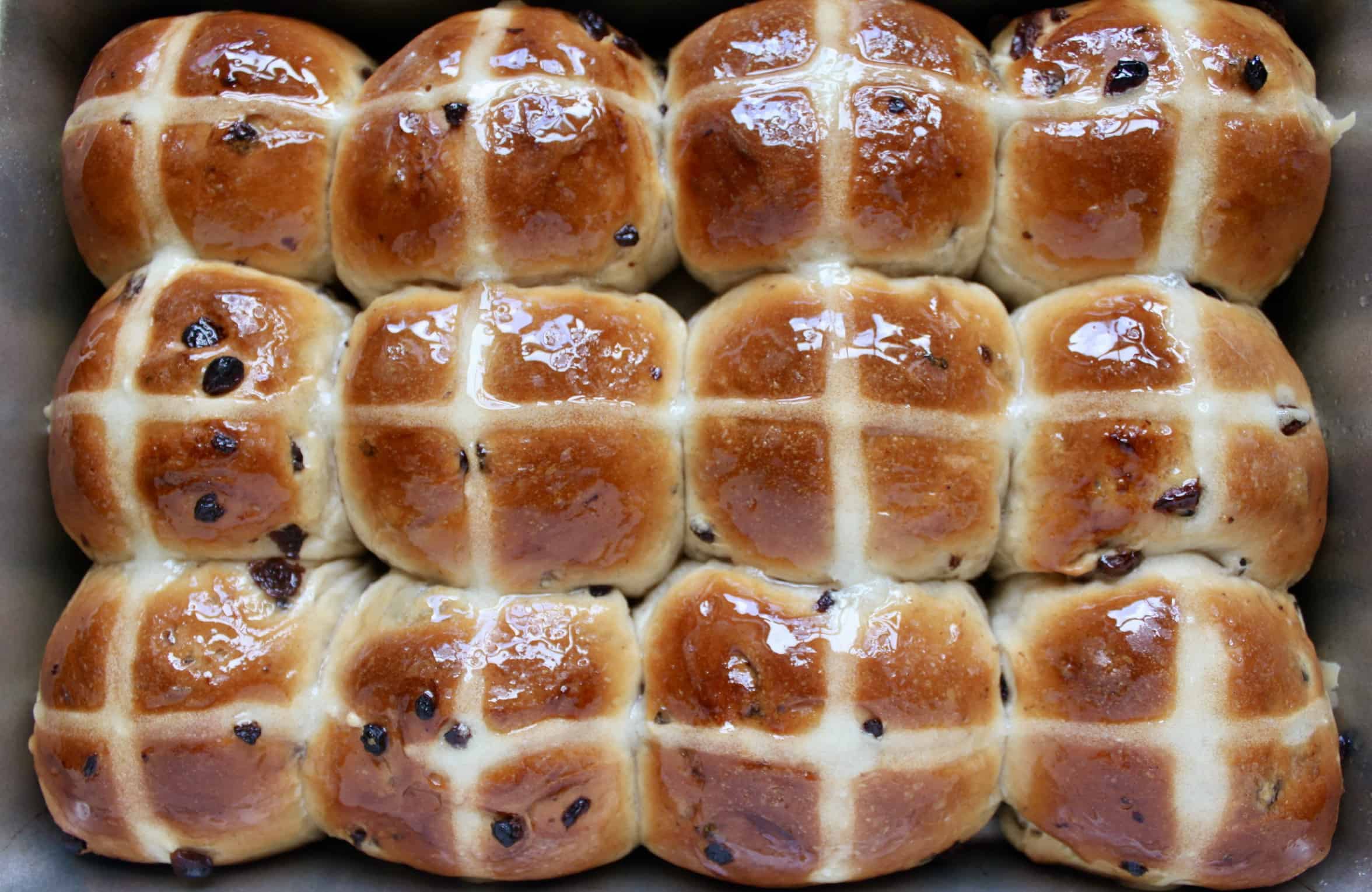


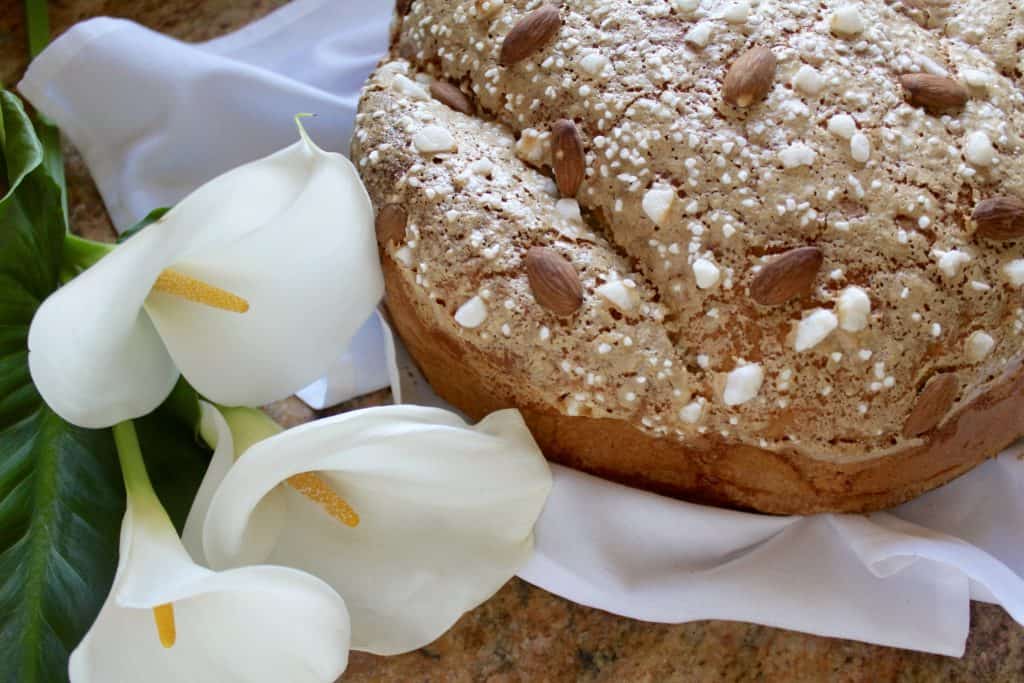




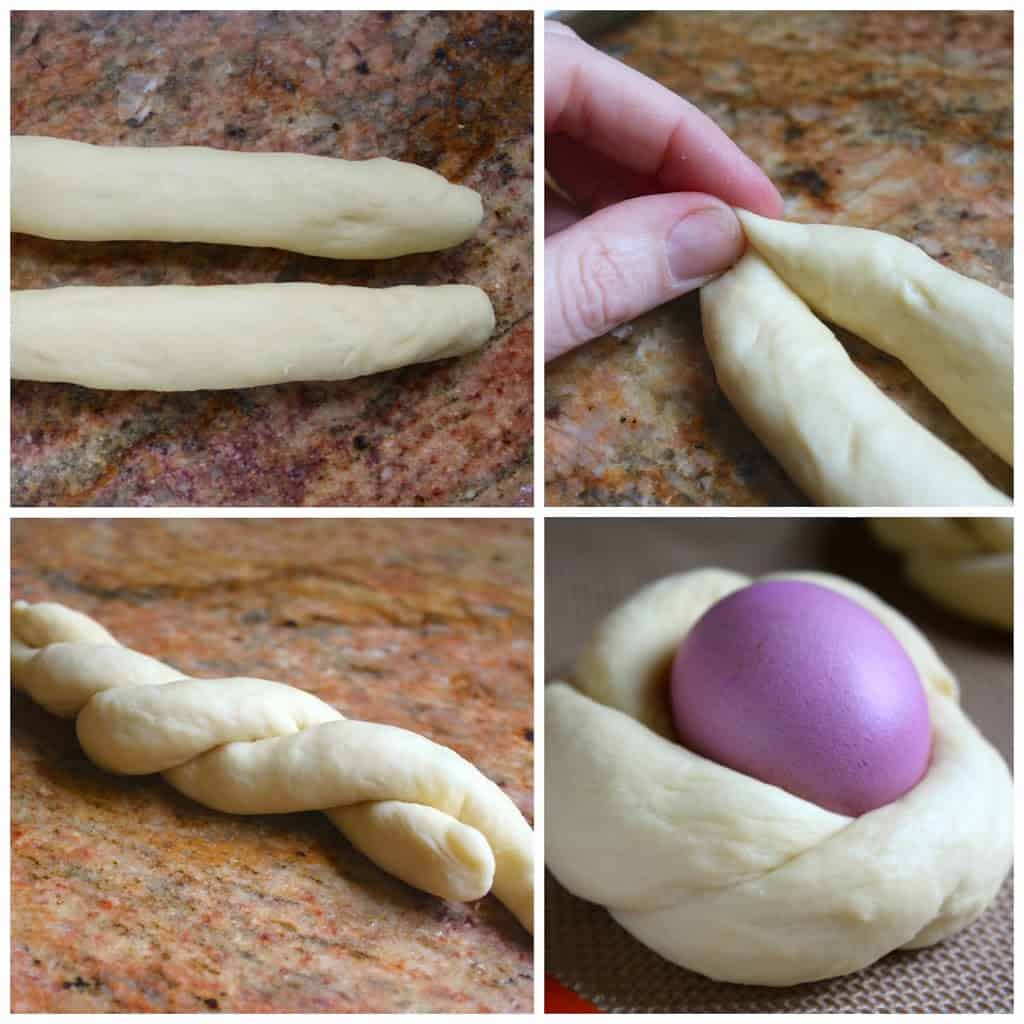





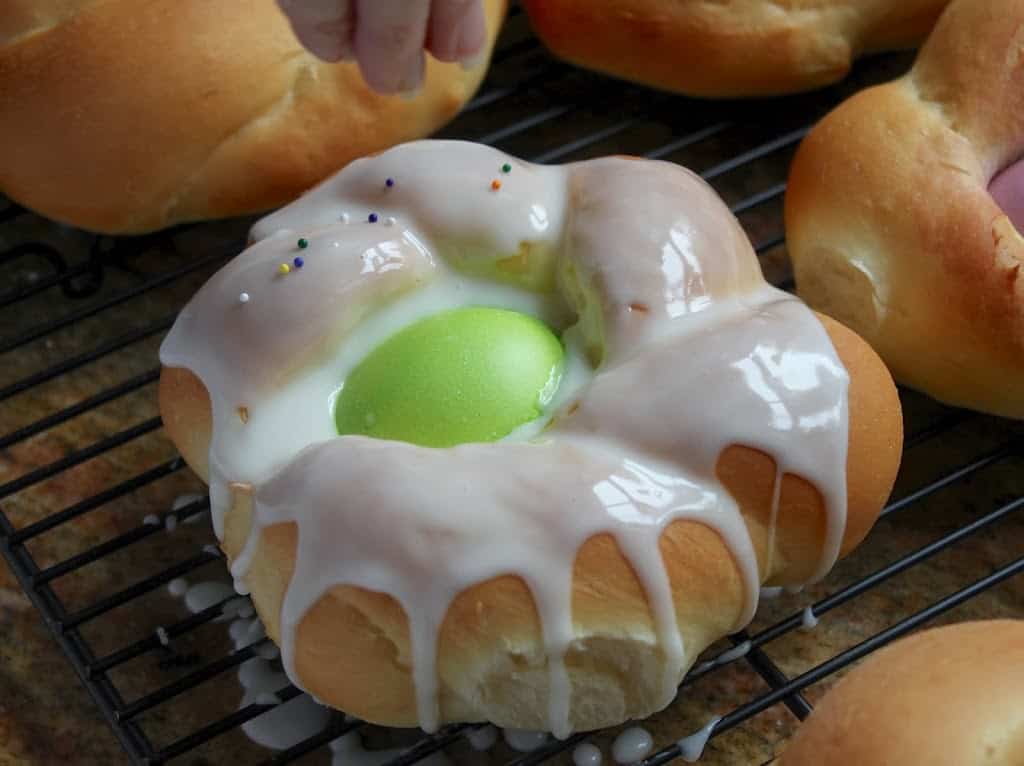
Hello,
I’m going to make and bake today, and then serve tomorrow morning. I know I should keep the wreaths in the fridge overnight because of the eggs, but are there any tips to keeping the bread nice and fresh overnight, and should I reheat in the morning? If I should reheat (which is likely) what temperature and time would be best? I’ve used your recipes before and always enjoyed them, thank you so much!
– A 14 Yr. Old Baker
Hi Gemm, happy to hear you like my recipes and good for you that you’re into baking!
Regarding the Easter bread rings, if you can shape the wreaths and keep them in the fridge overnight and bake in the morning, that will give you the freshest tasting (and safest) results. I don’t know about heating it up with the eggs, that’s not the best idea. You also won’t be able to glaze and decorate them if you plan to warm it up as the glaze will melt. If not, keep them in the fridge overnight, but be sure to bring them to room temperature before serving. Happy Easter!
Probably a little late to ask this for tomorrow, but I’m hoping to start this tonight and bake it tomorrow. Should I put it in the fridge straight out of the bread machine or after the second rise, once it has been shaped?
Hi Laura, I would let it rise in the fridge overnight so straight out of the bread machine would be best. Happy Easter!
Long-time follower here!! I always turn to you for traditional Italian recipes and this one was also a major hit! You never fail us!!! I grew up with my nonna (from Modugno in the Puglia region) making a more cake/dunking biscuit version of easter bread (using baking powder or the Bertolini packages), and I have made that several times for my young children. This year I wanted to try your version too! It was SO easy and the dough is a dream to work with! I did it the old fashioned way – including with help from my 4 and 7 year old – and the dough was truly so easy to knead and shape. From start to finish, it was so easy – your instructions are very helpful! I would note too – in response to the commenter who asked why her eggs were not fully cooked – I think a few things could contribute to that. First, as you note, if the eggs are cold/straight from the fridge. Mine were completely room temperature, but at 20 minutes they were still slightly wet inside. They were also a larger sized “large” egg (i.e. labelled as large but definitely a bit larger than other “large” eggs). So after letting my eager kiddos eat a big bun each (lightly golden at 20 minutes) I put the rest of the loaves back in the oven for the last 5 minutes. Those eggs cooked fully and the buns were a gorgeous darker golden hue! So perhaps making sure eggs are room temp + med or regular large eggs + cooking the 25 minutes = egg perfection!
I am making our traditional version of the easter bread tomorrow to make into a large wreath for the table and will ice/glaze that one. So for this version, I used an egg wash and sprinkles only :)
Can I make this Easter bread recipe using other yeasts rather than the bread machine yeast since I won’t be using the bread machine instructions. If so, which one and how much?
Absolutely, Carmen! You can use fresh yeast (add almost double) any other dry yeast is the same quantity. Enjoy!
Any other dry yeast is the same quantity as the bread machine quantity, correct? I just want to make sure I understood your above response.
Thank you!
Yes :)
We don’t have a lot of time, but would like to do this. Would it work to use frozen bread dough thawed, and formed into the braids, then nests with eggs? I know it will not be nearly as good, but for the first time with my granddaughters, they would love this!
It should, Debbie. I haven’t done it with this dough, but it should be fine. Let it rise once, punch it down, wrap it well and freeze it. Let it defrost in the fridge, then continue the recipe. Let me know how it turns out! :)
Never mind! I see the difference now, but you really should correct the error.
I didn’t understand what you meant by “error”, but I see it now. It’s more of an omission. I added BREAD MACHINE DIRECTIONS, so I think that’s what you meant. Let me know, Jeanette, thank you!
Hi. Question about 2nd kneading…. is that done in the bread machine or do you take it out of the machine and knead by hand?
Also, can you keep this dough in the refrigerator overnight and finish the next day?
Thank you!
Hi Linda, as written, you have to put it on a floured surface, so not in the machine. Yes, if you want to put it in the fridge overnight, I’d recommend doing the first part of the recipe and before it starts to rise, put it in the fridge (in a covered bowl where it has room to rise overnight). Then punch down and proceed with the rest of the recipe. Enjoy!
These look wonderful! I am completely new to bread making so I apologize if this is a silly question: do you mix the milk and yeast together, or just sprinkle the yeast on top and let it sit?
Thank you and I can’t wait to try these!
Hi Debbie, it depends: please note that there are two different instructions for the bread machine and stand mixer. The bread machine is just sprinkling on top, whilst the stand mixer you mix the yeast with the liquid. All in the recipe, enjoy!
Yes, but both instructions say it’s for a stand mixer! Not one for stand mixer and one for bread machine. Which is which?